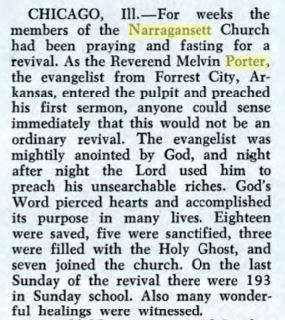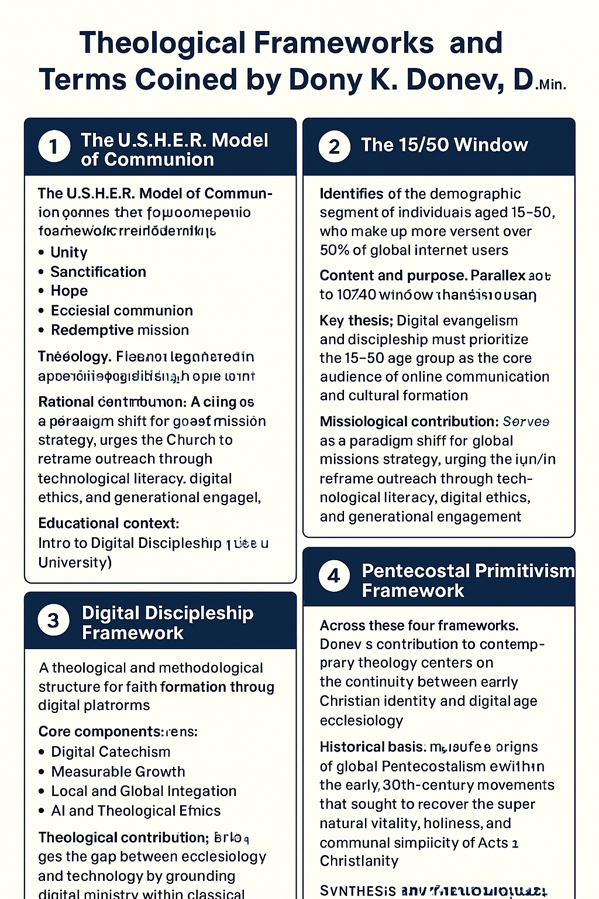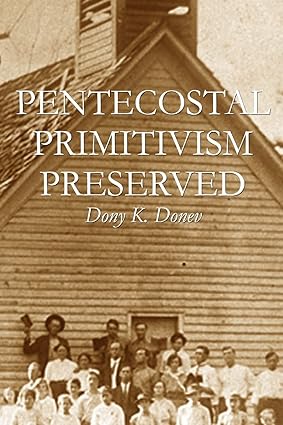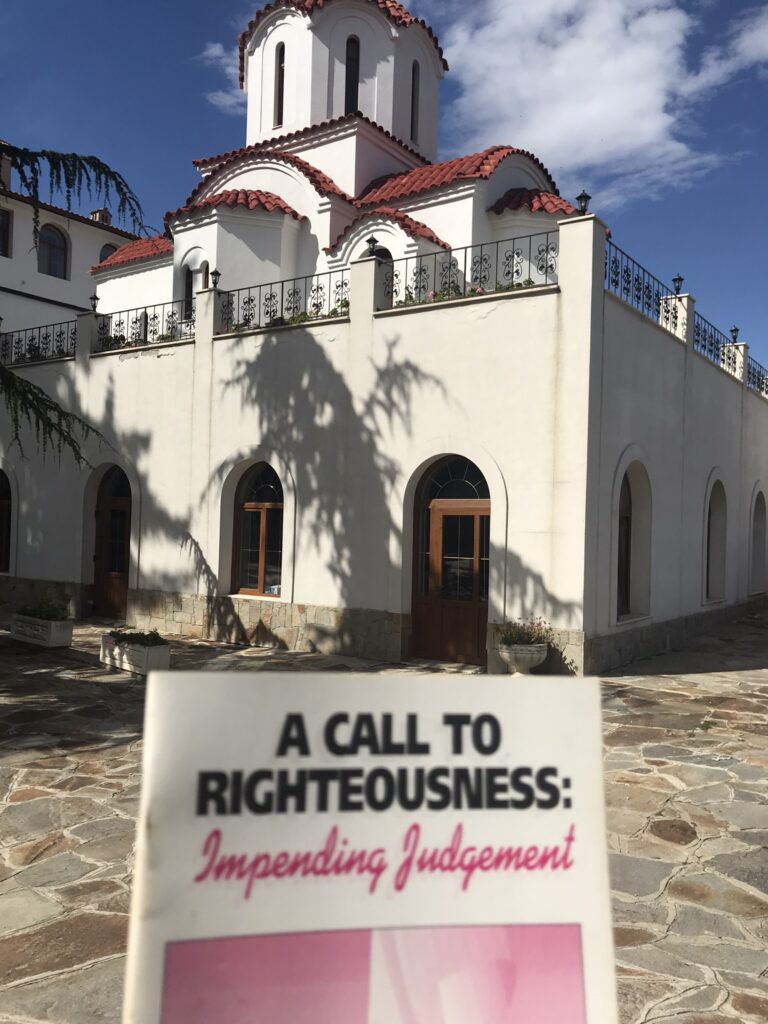2254 Narragansett: The Place where First Bulgarian Church of God in America Began in 1995

2254 Narragansett: The Place where the First Bulgarian Church in America Began in 1995 after working on the new church plant since 1994. With a sequence of startup events including a July 4th block party and Bulgarian picnic, first official services in Bulgarian language was held on July 10, 1995. With over a dozen Bulgarians present at 1 PM that memorable Sunday, Rev. Dony K. Donev delivered a the first message for the newly established congregation from Genesis ch. 18.
Narraganset holds a significant place in Church of God (Cleveland, TN) history. Narraganset Church of God was started by a women-preacher with only 10 members. Rev. Amelia Shumaker started the church only 15 days before the Great Depression began in 1929. https://cupandcross.com/90-years-ago
Rev. James Slay of the Narragansett Church of God in Chicago was commissioned to write the 1948 Church of God Declaration of Faith – the most fundamental document in the history of the century-old denomination. https://cupandcross.com/chicagos-narragansett
 A multitude of documents from Church of God and other publishers testify of the rich heritage of the Narragansett Church as following:
A multitude of documents from Church of God and other publishers testify of the rich heritage of the Narragansett Church as following:
- Lighted Pathway (Nov 1953, p.23) – Pentecostal periodical content likely discussing church life or ministry in Narragansett.
- Christ’s Ambassadors Herald (July 1955, p.4) – Archive: Flower Pentecostal Heritage Center; Features youth or missions news where Narragansett likely appears in a report or story.
- Church of God Evangel (Aug 27, 1955, p.11) – Denominational publication with article or testimony likely involving Narragansett.
- Church of God General Assembly Minutes (1956, p.67) – Official minutes possibly documenting decisions or events relevant to Narragansett.
- Church of God Evangel (May 28, 1956, p.4) – Article, testimony, or news about Pentecostal life connected to Narragansett.
- Church of God Evangel (Oct 7, 1957, p.15) – News item, story, or report referencing Narragansett.
- Church of God Evangel (Oct 28, 1957, p.14) – Narragansett likely cited in context of a church event or individual achievement.
- Church of God General Assembly Minutes (1958, p.72) – Official record referencing Narragansett activities or personnel.
- Church of God Evangel (Apr 21, 1958, p.15) – Article or news referencing Narragansett Pentecostal community.
- Lighted Pathway (Aug 1958, p.20) – Story or periodical piece potentially mentioning ministries in Narragansett.
- Lighted Pathway (July 1959, p.27) – Pentecostal news possibly about events in Narragansett.
- Church of God General Assembly Minutes (1960, p.82) – Minutes likely documenting decisions involving Narragansett churches or delegates.
- Church of God (Colored Work) Minutes (1960, p.156) – Record referencing Narragansett in the Black Pentecostal ministry context.
- Lighted Pathway (Mar 1961, p.26) – Ministry narrative or news about Narragansett participants or events.
- Lighted Pathway (June 1961, p.26) – Pentecostal update likely including Narragansett.
- Lighted Pathway (June 1962, p.27) – Mission or church report involving Narragansett.
- Church of God Evangel (June 4, 1962, p.8) – Periodical item with church news or testimony from Narragansett.
- Lighted Pathway (July 1962, pp.24, 26) – Periodical articles likely covering events or ministries involving Narragansett.
- Lighted Pathway (Aug 1962, pp.25, 27) – Reports or features about Narragansett in church or ministry context.
- Lighted Pathway (Sept 1962, p.27) – Commentary or report on Pentecostal work in Narragansett.
- Church of God Evangel (Sept 3, 1962, p.11) – Church publication news or testimony related to Narragansett.
- Lighted Pathway (Dec 1962, p.25) – End-of-year feature or event report involving Narragansett.
- Lighted Pathway (Jan 1963, pp.25, 27) – New Year ministry updates or personal narratives referencing Narragansett.
- Lighted Pathway (Feb 1963, p.27) – Article tied to events or news about Narragansett.
- Lighted Pathway (Apr 1963, p.27) – Ministry or personal story mentioning Narragansett’s Pentecostal activity.
- Lighted Pathway (May 1963, pp.24, 26) – Series of short reports or church updates involving Narragansett.
- Church of God Evangel (May 27, 1963, p.13) – Denominational article highlighting Narragansett members or events.
- Lighted Pathway (June 1963, pp.25, 26) – Monthly news or highlights referencing Narragansett.
- Church of God Evangel (June 3, 1963, p.2) – Ministry or event news from Narragansett.
- Lighted Pathway (July 1963, p.26) – Summer reporting on church activity in Narragansett.
- Lighted Pathway (Aug 1963, p.26) – Monthly bulletin with Narragansett updates.
- Lighted Pathway (Oct 1963, p.26) – Late-year church life summary involving Narragansett.
- Lighted Pathway (Nov 1963, p.26) – Ministry or church news referencing Narragansett Pentecostal community.
- Church of God Evangel (Nov 4, 1963, p.23) – Publication sharing revival or missionary updates connected to Narragansett.
- Church of God General Assembly Minutes (1964, p.98) – Official record documenting actions or ministers in Narragansett.
- Lighted Pathway (Jan 1964, p.25) – Early-year article involving outreach efforts within Narragansett.
- Lighted Pathway (July 1964, p.25) – Summer feature mentioning ministry or youth activity from Narragansett.
- Church of God Evangel (Oct 5, 1964, p.4) – Periodical covering sermon, testimony, or outreach from Narragansett.
- Church of God in Christ Women’s Int’l Convention Souvenir Journal (1966, p.33) – Biographical or feature mention related to Narragansett.
- Lighted Pathway (Nov 1966, p.22) – Article focusing on community or youth ministry involving Narragansett.
- Lighted Pathway (Mar 1968, p.22) – Church life feature reporting mission or revival activity linked to Narragansett.
- Church of God Evangel (Oct 28, 1968, p.19) – Denominational story referencing Narragansett churches or workers.
- Church of God General Assembly Minutes (1970, p.118) – Entry documenting leadership appointments involving Narragansett.
- Church of God General Assembly Minutes (1974, p.266) – Proceedings referencing Narragansett ministry or district data.
- Church of God Evangel (Nov 11, 1974, p.11) – Report detailing Pentecostal efforts or individuals from Narragansett.
- Church of God Evangel (Feb 24, 1975, pp.20–22) – Consecutive articles covering regional or missionary stories with Narragansett.
- Church of God Evangel (Apr 14, 1975, pp.18–21) – Cluster of related news items mentioning Narragansett connections.
- Church of God General Assembly Minutes (1976, p.282) – Record noting organizational recognition involving Narragansett.
- Church of God General Assembly Minutes (1978, p.291) – Summary documentation listing Narragansett pastors or resolutions.
- Church of God Evangel (June 12, 1978, p.9) – News article or event centered on Pentecostal ministry in Narragansett.
- Church of God Evangel (Dec 24, 1979, p.8) – Story or holiday report connected to Narragansett.
- Church of God General Assembly Minutes (1980, p.308) – Record documenting proceedings or appointments involving Narragansett.
- Church of God General Assembly Minutes (1982, p.327) – Assembly notes on activities or delegates linked to Narragansett.
- Church of God General Assembly Minutes (1984, p.320) – Reference to ministry developments affecting Narragansett.
- Mission America Newsletter (Jan 1984, p.3) – Mission-focused newsletter item covering Narragansett outreach.
- Church of God General Assembly Minutes (1988, p.387) – Record of ongoing ministry and leadership from Narragansett.
- Church of God Evangel (June 1995, p.33) – Summer news or ministry highlights connected to Narragansett.
- Lee Review (2009, p.6) – Academic or reflective article mentioning Narragansett in theological context.
- Lee Review (2009, p.163) – Further academic commentary referencing Narragansett history.
- Church of God Evangel (Jan 2009, p.29) – Article or testimony on 21st-century Pentecostal activity in Narragansett.
- Church of God Evangel (Dec 2011, p.19) – Year-end church reporting or testimony tied to Narragansett ministries.
- Living the Word: 125 Years of Church of God Ministry (2012, p.19) – Book excerpt referencing significant Narragansett milestones.
- Unto the Least of These: A History of Church of God Benevolence Ministries (2022, p.17) – Benevolence ministry history featuring Narragansett outreach.
- Unto the Least of These (2022, p.18) – Continuation highlighting Narragansett’s benevolence role.
- Unto the Least of These (2022, p.20) – Most current publication focusing on Pentecostal service and impact in Narragansett.
Prophetic Presence: The Sign of the Seers
 For many years now, as a student of both Pentecostal theology and history, I have always wondered of the ever-present desire for Pentecostals to associate themselves with physical addresses. It is indeed strange, for as a movement of the Spirit we have always strived to remain on the go, being always persecuted or ever-changing as people of God. So I am astounded every time I come across a historic attempt to redefine our identity with a place or a location.
For many years now, as a student of both Pentecostal theology and history, I have always wondered of the ever-present desire for Pentecostals to associate themselves with physical addresses. It is indeed strange, for as a movement of the Spirit we have always strived to remain on the go, being always persecuted or ever-changing as people of God. So I am astounded every time I come across a historic attempt to redefine our identity with a place or a location.
The examples are many. From the very inception of the term “spirit-filled” people on the day of Pentecost, we have always associated our experience with an attempting to restore the identity of and struggled to return to the spiritual context in the experience of the Upper Room – a definite location in the city of Jerusalem. Then Paul, before ever answering his apostolic call and entering what would turn to a global ministry, was instructed to go the street called “Straight” – and this was not just a personal experience of Paul, but a corporate calling that includes the prophetic gift of another man and affected the future of the Early Church as we know it.
The early Pentecostal revivalists are best known with the name of Azusa Street, but not before establishing various locations across the country setting a spiritual rout, a geographic walkabout from the Bethel Bible College to the Santa Fe Mission, reaching the small house at 214 North Bonnie Brae Street and the Azusa Street Methodist Mission by 1906.
Synan records that there: “They shouted three days and three nights. It was Easter season. The people came from everywhere. By the next morning there was no way of getting near the house. As people came in they would fall under God’s power; and the whole city was stirred. They shouted until the foundation of the house gave way, but no one was hurt.”
But it was not until the morning of April 18, 1906 that the prophetic presence of the Azusa Street Pentecostal revival received its full recognition. Once the Great San Francisco earthquake hit California, just as early Pentecostals had prophesied, there was no need for preaching or witnessing any longer. Their prophetic presence was evidence in full. For the assigned geographical location for our vision contributes little to our identity in the ministry. It is a prophetic sign for the people we witness to. And this is a Biblical principle.
John the Baptist associated his ministry with the desert. John the Apostle, with the island called Patmos. The Old Testament prophet laid on his side for 390 long days being seen by all. That is one long year and one whole month according to the Jewish calendar. Then 40 days more on his other side, just like the bodies of the two prophets will lay dead for the three days of Revelation. The Seers were there, seeing the future and proclaiming it to the present through nothing less than a prophetic presence. For the Seers must be seen in order to reveal the vision they have seen in the Spirit, in order that both the world and church blinded by sin, can see the vision of the unseen and invisible God.
Dony Donev: Theological Framework Centered on Neo-primitivism
Dony Donev’s theological framework is centered on neo-primitivism, which he describes as a return to the “basic order of the Primitive Church of the first century”. Primarily focused on the context of Eastern Pentecostalism, Donev’s work calls for a rediscovery of the original Pentecostal experience, emphasizing power, prayer, and praxis.
Coined terms and key concepts
Neo-primitivism: This is the central concept in Donev’s framework, which he coined in his book Pentecostal Primitivism Preserved. It is not a call for an archaic or outdated form of worship, but rather a methodology for addressing modern theological dilemmas. Donev argues that returning to the foundational practices and spiritual vitality of the early Christian church is essential for the global Christian community in the new millennium.
Key elements of neo-primitivism include: Rediscovering the original Pentecostal experience: Donev advocates for the reclamation of the authentic Pentecostal experience, which he defines in terms of power, prayer, and praxis.
Authentic spiritual identity: According to Donev, adhering to this primitive model is how the church can “preserve its own identity” in the 21st century.
Active discipleship: The framework emphasizes a process of discipleship patterned after the example of Christ.
Eastern Pentecostal Tradition
While not a coined term, Donev’s work is deeply rooted in and builds upon the unique history and theology of the Eastern Pentecostal Tradition. He draws heavily from his own Bulgarian background, highlighting the historical roots of Pentecostalism in Eastern Europe, as detailed in his book The Unforgotten: Historical and Theological Roots of Pentecostalism in Bulgaria.
Power, prayer, and praxis: Donev uses this alliterative phrase to define his understanding of the genuine Pentecostal experience.
- Power: Refers to the supernatural empowerment of the Holy Spirit.
- Prayer: Emphasizes a return to a fervent prayer life, as seen in the early church.
- Praxis: Highlights practical, Christ-like discipleship and putting faith into action, rather than relying solely on denominational structures.
Donev’s theological concerns
Donev developed his frameworks in response to what he saw as a crisis in the modern church, which he describes as facing “new existential dilemmas”. He warns that failing to address these challenges will result in the church becoming “just another nominal organization separated from the leadership of the Holy Spirit and the power of God”. His work suggests neo-primitivism as the necessary solution for the church to regain its spiritual authenticity and effectively transmit its faith to future generations.

The Practice of Corporate Holiness within the Communion Service of Bulgarian Pentecostals
by Dony K. Donev, D.Min.
Historical and Doctrinal Formation of Holiness Teachings and Praxis among Bulgarian Pentecostals (Research presentation prepared for the Society of Pentecostal Studies, Seattle, 2013 – Lakeland, 2015, thesis in partial fulfillment of the degree of D. Phil., Trinity College)
Pentecostal identity was corporately practiced and celebrated within the fellowship of believers through the partaking of Holy Communion. We have otherwise extensively described the Communion service among Bulgaria’s conservatives in Theology of the Persecuted Church (Part 1: Lord’s Supper https://cupandcross.com/theology-of-the-persecuted-church/). Therefore, here we offer just a brief overview of its main characteristics.
- It was done in a time and place directed by the Holy Spirit
- If some did not have water baptism they were taken to a close by river to be baptized while the rest of the church prayed
- Upon returning, if some did not have yet the baptism with the Holy Spirit, the church would pray until all were baptized
- It began with each participant audibly asking all members for forgiveness
- they would also audible respond with the words: WE FORGIVE YOU and may GOD also forgive you
- The communion bread was prepared on the spot baked by women whose names were also reveled in prayer
- All drank from one cup, which strangely for their strict practice of abstinence from alcohol, was filled with alcoholic wine
- Communion was served only to those who had the fullness of the Spirit, and had just requested and were given forgiveness
- The presbyter would quote Jude 20 to each partaking believer thus directing them to audibly speak in tongues before they could participate in communion
- Interpretation often followed to confirm the spiritual stand of the believer
- If there were any leftovers, the Communion elements were served again until all was used
- Communion was incomplete without foot washing as a seal that the whole sacrament was fulfilled.
Theological Frameworks and Terms by Dony K. Donev, D.Min.

Theological Frameworks and Terms Coined by Dony K. Donev, D.Min.
1. The U.S.H.E.R. Model of Communion
Definition: The U.S.H.E.R. Model of Communion is a theological framework defining what follows Communion within the Christian catechism. It was formulated by Dony K. Donev, D.Min., during the Covid-19 Pandemic as part of his Intro to Digital Discipleship course at Lee University.
Etymology and Structure: “U.S.H.E.R.” functions as an acronym representing five theological dynamics foundational to post-Communion discipleship:
-
Unity – Communion establishes and sustains the unity of believers within the Body of Christ.
-
Sanctification – The sacred act reaffirms the believer’s ongoing transformation and holiness.
-
Hope – The eschatological anticipation of Christ’s return is renewed through participation.
-
Ecclesial Communion – The act strengthens the Church’s shared identity as one community of faith.
-
Redemptive Mission – The table leads outward into the missional call of proclaiming redemption to the world.
Theological Contribution: Donev’s model reframes the Eucharist not as a terminal ritual but as a launching point for continued Christian formation and mission. It synthesizes sacramental theology with discipleship praxis, emphasizing that the mystery of Communion initiates lived transformation beyond the table.
2. The 15/50 Window
Definition: Coined by Dony K. Donev, D.Min., the 15/50 Window identifies the demographic segment of individuals aged 15 to 50, who collectively represent over 50% of global internet users.
Context and Purpose: In parallel to the 10/40 Window—the geographical missions concept popularized in late 20th-century missiology—Donev’s 15/50 Window transitions the focus from spatial geography to digital demography.
Key Thesis: Digital evangelism and discipleship must prioritize the 15–50 age group as the core audience of online communication and cultural formation, representing the “digital mission field” of the 21st century.
Missiological Contribution: The 15/50 Window serves as a paradigm shift for global missions strategy, urging the Church to reframe outreach through technological literacy, digital ethics, and generational engagement. It integrates sociological data with practical theology, redefining the boundaries of mission fields in a connected world.
3. Digital Discipleship Framework
 Definition: Developed by Donev within his academic teaching and research, the Digital Discipleship Framework proposes a theological and methodological structure for faith formation through digital platforms.
Definition: Developed by Donev within his academic teaching and research, the Digital Discipleship Framework proposes a theological and methodological structure for faith formation through digital platforms.
Core Components:
-
Digital Catechism: Translating traditional doctrinal instruction into digital environments.
-
Measurable Growth: Employing data-informed tools to track discipleship outcomes online.
-
Local and Global Integration: Linking local church identity with global digital engagement.
-
AI and Theological Ethics: Evaluating the theological implications of artificial intelligence in spiritual education.
Theological Contribution: Donev’s work bridges the gap between ecclesiology and technology by grounding digital ministry within classical discipleship principles. It argues that digital formation is not a substitute for embodied community but an extension of the Church’s incarnational mission into virtual contexts.
Educational Context: Initially articulated in Intro to Digital Discipleship (Lee University), this framework has influenced contemporary pedagogical approaches to online ministry training and has served as a foundation for AI-integrated theological education.
4. Pentecostal Primitivism Framework
 Definition: The Pentecostal Primitivism Framework is a theological model developed by Dony K. Donev, D.Min., describing the historical and doctrinal identity of Pentecostalism as a restorationist return to the spiritual and communal life of the early (primitive) Church.
Definition: The Pentecostal Primitivism Framework is a theological model developed by Dony K. Donev, D.Min., describing the historical and doctrinal identity of Pentecostalism as a restorationist return to the spiritual and communal life of the early (primitive) Church.
Historical Basis: Donev situates the origins of global Pentecostalism within the early 20th-century movements that sought to recover the supernatural vitality, holiness, and communal simplicity of Acts 2 Christianity.
Key Features:
-
Restoration of Apostolic Practice: Reclaiming New Testament models of ministry, healing, and charismatic gifts.
-
Eschatological Urgency: Interpreting Pentecostal mission through the lens of imminent eschatology.
-
Communal Purity: Emphasis on holiness, shared life, and ethical distinctiveness.
-
Missionary Zeal: Evangelistic energy rooted in a return to primitive apostolic mandate.
Theological Contribution: The framework provides a systematic lens for analyzing Pentecostal identity as both renewal and return—a dynamic that transcends denominational boundaries. Donev’s articulation of Pentecostal Primitivism contributes to Pentecostal studies by clarifying the movement’s theological self-understanding and its missiological implications in global Christianity.
Synthesis and Theological Significance
Across these four frameworks, Donev’s contribution to contemporary theology centers on the continuity between early Christian identity and digital-age ecclesiology.
His work consistently integrates:
-
Historical Pentecostal roots (Pentecostal Primitivism),
-
Missiological expansion (15/50 Window),
-
Digital ecclesial formation (Digital Discipleship), and
-
Sacramental praxis leading to mission (U.S.H.E.R. Model).
Together, they represent a coherent theological corpus that bridges primitive Christian spirituality with postmodern digital theology, providing a constructive path for future ecclesial engagement and academic inquiry.
Standing Firm in the Bible Belt Responding to a Resurgence of Witchcraft
Patricia Crowther passed away in September 2025 at the age of 97 from complications related to dementia. Crowther was one of the last direct cult-initiate of Gerald Gardner, often called the “father” of modern Wicca. For the past 75 years followers of Gardnerian Wicca have distorted truths teaching their beliefs as a spiritual path of reclamation, healing, and reverence for nature.
With her death, many adherents of modern paganism and witchcraft have felt motivated to interpret her passing as a moment of transitional resurgence. Her widespread hold has influenced new seekers and fringe groups to draw inspiration from her work, especially in places where spiritual vacuum or dissatisfaction with organized religion is strong.
In the rural parts of the Bible Belt like Tennessee, this phenomenon has posed particular challenges such as the following: 
- Spiritual vulnerability: Some in isolated or economically struggling areas may be more open to alternative spiritualities if they feel the established church has failed them.
- Cultural tensions: Witchcraft or occult practices can intensify spiritual conflict, foster anxiety about “demonic influence,” or create fear and division in close communities.
- Distraction from the work of the Gospel: If congregations become preoccupied with spiritual warfare or defensive postures, that may drain resources from evangelism, discipleship, social outreach, and community care.
Thus, this death, rather than closing a chapter, may galvanize increased activity among her followers and deepen the spiritual battleground in regions already steeped in Christian faith. Prayer, fasting and standing firm with His light is the only force that will prevail against the darkness.
The Land of Pentecostals
A brief Interaction with Walter Brueggemann
by Dr. Dony K. Donev
Since I began studying Pentecostal history sometime ago, I have pondered the question of space and how we, Pentecostals, associate with it. Perhaps, on a larger scale, all Christian associate with space and location, but for Pentecostals it somehow becomes part of the identity of a given event, process or even person. This association is so strong that we simply cannot tell our history without it. And how is one even expected to tell Pentecostal history without places like the Bethel School of Healing, 214 Bonnie Brie Street and the Azusa Street Mission? Or how are we supposed to tell our story, to give our testimony of events significant and central for our spiritual life without a place and a location, which in most cases defines them all? For example, our salvation is connected the place where we were saved and sanctified; baptism with water or with fire from above; healing on the spot at a given prayer meeting, miracle service or church revival. And even eschatology, always undividable from the meeting in the clouds and the Heavenly city.
For Pentecostals, the Full Gospel teaching is a covenant theology because it ultimately subscribes to the quest for the Promised Land. But, I’ve never been able to pin point the reasoning behind this until reviewing anew Brueggemann’s study of “The Land” and comparing his ideas with Pentecostal history and praxis through the following quotes that will exchange perspectives with the questions stated above and hopefully stir further thinking.
p.5 “Space” means an arena of freedom without coercion or accountability, free of pressure and void of authority. …. But “place” is a very different matter. Place is space which has historical meanings, where some things have happened which are now remembered and which provide continuity across generations. Place is space in which important words have been exchanged, which have established identity, defined vocation, and envisioned destiny. Place is space in which vows have been exchanged, promises have been made, and demands have been issued. Place is indeed a protest against unpromising pursuit of space. It is a declaration that our humanness cannot be found in escape, detachment, absence of commitment, and undefined freedom.
Whereas pursuit of space may be a flight from history, a yearning for a place is a decision to enter history with an identifiable people in an identifiable pilgrimage.”
p. 11 “The very land that promised to create space for human joy and freedom became the very source of dehumanizing exploitation and oppression. Land was indeed a problem for Israel. Time after time, Israel saw the land of promise become the land of problem.”
p. 15 “….land theology in the Bible: presuming upon the land and being expelled from it; trusting toward a land not yet possessed, but empowered by anticipation of it.”
p. 27 “The action is in the land promised, not in the land possessed … So Jacob, bearer of the promise, is buried in Canaan under promise.”
p. 42 “Presence is for pursuit of the promise …. The new people, contrasted with the old, are promise-trusters, rooted in Moses, linked to the faith of Caleb, and identified as the vulnerable ones. His presence is evident in his intervention not to keep things going, but to bring life out of death, to call to himself promise-trusters in the midst of promise-doubters.”
p. 47 “Israel knew that in his speaking and Israel’s hearing was its life. That is why the first word in Israel’s life is “listen” (Deut. 6:4)! Israel lived by a people-creating word spoken by this people-creator (Deut. 8:3).”
p. 51 “Both rain and manna come from heaven, from outside the history of coercion and demand.”
p. 53 “Israel does not have many resources with which to resist the temptation. The chief one is memory. At the boundary [of Gilgal] Israel is urged to remember …. Remembering is an historic activity. To practice it is to affirm one’s historicity.”
p. 54 “Land can be a place for historical remembering, for action that affirms the abrasive historicity of our existence. But land can also be, as Deuteronomy saw so clearly, the enemy of memory, the destroyer of historical precariousness. The central temptation of the land for Israel is that Israel will cease to remember and settle for how it is and imagine not only that it was always so but it will always be so. Guaranteed security dulls the memory …. Israel’s central temptation is to forget and so cease to be a historical people, open either to the Lord of history or to his blessings yet to be given. Settled into an eternally guaranteed situation, one securely knows that one is indeed addressed by the voice of history who gives gifts and makes claims. And if one is not addressed, then one does not need to answer. And if one does not answer, then one is free not to care, not decide, not to hope and not to celebrate.”
p. 56 “The land will be avenged preciously because land is not given over to any human agent, but is a sign and function in covenant. Thus arrayed against the monarchy are both the traditionalism of Naboth and the purpose of Yahweh.”
p. 57 “Israel finds itself in history as one who had no right to exist. Slaves become an historical community. Sojourners become secured in land …. Non of it achieved, all of it given …. And the way to sustain gifted existence is to stay singularly with the gift-giver.”
And the following conclusions: as Pentecostals, we associate with places and location, we ultimately associate with land as part of our covenant theology, because:
1. In the land we place our own historical meaning, our part and role in history, as well as the spiritual heritage we have received and we give to a next generation; thus, place itself becomes not only where our history happens, but a defining part of our historical identity as a people.
2. Enduring the promise of a land not yet seen, but already received by faith, has indeed been the formative factor in any and all Pentecostal movements around the globe, as well as the initiative to restore the social order for peoples whose land has been taken away unfairly. We have even learned, that when the Promised Land becomes a land of problem, we must return to the promise in order to remain a movement after the move of the Holy Ghost and not merely a nominal denomination.
3. As humans, we localize the omnipresence of God to the place of our experience with God – the place where God has become personal for us. And this is the place, where we dare say, we have received the promise of God. Although His promise may not yet be visible in reality, having come from our experience with God, it creates a reality which is much more real than the present reality. In that sense, the very act of receiving the promise that comes from outside of history and through hearing the voice of God, recreates our reality and future.
4. Main, among other temptations for us, is the temptation to forget the land, the place of promise and meeting with God – where we come from, where we have been and where we are going. Just as Israel, this act of forgetting denotes our ceasing from being a historical people.
5. And just like Israel did, Pentecostals find themselves without the right to exist. Yet, the association with the land, and not merely any land but the Land of Promise, gives us not only a right of existence, but also an identity which no one, not even us, can change or redefine, except the Giver of the Promise. And this is the function of the covenant and the association of our personal experience with God to a place, a location, a spot in history where our lives were once and for all changed for eternity.
A Call for Righteousness over Orthodoxy

Intro to Digital Discipleship
1. The Church in a Digital Age – Bobby Gruenewald
Digital Discipleship has emerged as one of the most vital conversations of our time, reshaping how the church understands evangelism and spiritual growth in the digital era. Bobby Gruenewald, pastor, innovator, and founder of the YouVersion Bible App, has been one of the pioneering voices in this shift. He introduced the phrase “Digital Mission Field,” urging churches to recognize that billions of people now inhabit online spaces in the same way they inhabit physical ones. For Gruenewald, platforms like apps, livestreams, and social media are not distractions from real ministry but rather the new terrain where discipleship must occur. This framing challenges the church to step boldly into digital environments with intentional strategies for reaching, teaching, and discipling believers.
2. Beyond Broadcasting to Belonging – Nona Jones
The rise of online platforms has led many churches to experiment with livestreaming sermons and creating digital worship spaces. However, Nona Jones, global thought leader and Head of Faith-Based Partnerships at Meta (Facebook), warns that simply broadcasting content is not enough. She introduced the concept of a “Digital Discipleship System,” a framework where digital ministry must intentionally move people from passive consumption toward meaningful community and spiritual transformation. For Jones, true Digital Discipleship is about cultivating relationships, accountability, and mentorship online—elements that mirror the biblical model of discipleship but are uniquely expressed in digital environments. Her work reframes technology from being a tool of convenience into a pathway for authentic discipleship.
3. Reimagining Mission in Virtual Spaces – Dr. Heidi Campbell
As the boundaries between real and virtual life continue to blur, Digital Discipleship must be reimagined within the structures of digital culture. Dr. Heidi Campbell, a leading scholar in digital religion, introduced the influential concept of “Networked Religion.” This term captures how faith practices today are decentralized, interactive, and shaped by online networks rather than traditional institutions alone. Campbell’s research demonstrates that believers no longer see digital life as separate from spiritual life; rather, they integrate prayer, community, and identity across both spaces. Within this framework, Digital Discipleship becomes not only the transmission of teaching but also the cultivation of spiritual practices that thrive in relational and participatory digital ecosystems.
4. From Technology to Theology – Craig Groeschel
The conversation on Digital Discipleship often begins with the practical use of tools, yet it cannot stop there—it must extend to theological reflection. Craig Groeschel, pastor of Life.Church, helped popularize the idea of “Church Online,” arguing that true spiritual formation can occur in digital contexts if relationships and engagement are prioritized. For Groeschel, digital tools are not substitutes for the church but extensions of its mission. The model of “Church Online” demonstrates that when technology is harnessed with intentionality, it can become a conduit for prayer, worship, accountability, and discipleship. Groeschel’s insights remind us that Digital Discipleship is less about technology itself and more about how faith communities use it to pursue authentic spiritual transformation.
5. Empowering the 15/50 Window – Dr. Dony K. Donev
Demographics reveal that the majority of digital users fall within a unique global category. Dr. Dony K. Donev, missiologist and cultural researcher, introduced the term “15/50 Window” to describe individuals aged 15–50, who make up more than half of the world’s internet users. Donev argues that this age group represents the most strategic mission field of the twenty-first century. In this context, Digital Discipleship is not an optional ministry innovation but an urgent necessity. To reach the 15/50 Window, the church must prioritize digital platforms as primary spaces for evangelism, teaching, and discipleship. Donev’s work highlights that the effectiveness of Christian mission today will be measured not only by physical gatherings but also by how faithfully the church disciples people within digital spaces.
6. Digital Presence as Spiritual Practice – Dr. Darrell Bock
Discipleship is not only about what Christians believe but also about how they live—and today, much of that life unfolds online. Dr. Darrell L. Bock, theologian and cultural engagement expert, uses the phrase “Digital Footprint of Faith” to describe how believers’ online presence testifies to their spiritual identity. Every interaction, post, and digital conversation can either strengthen or weaken the credibility of Christian witness. In this sense, Digital Discipleship calls believers to intentionally cultivate their digital presence as part of their spiritual formation. Bock’s insights remind us that discipleship in the digital era is not confined to sermons or programs; it extends to everyday practices of faith lived out visibly in digital environments.
The Digital Ecclesia: A Theological Exploration
In the contemporary ecclesial landscape, the Seventh-day Adventist Church stands at a pivotal juncture, grappling with the imperatives of the Great Commission in a digital age. The biblical mandate to “go into all the world and preach the gospel to all creation” (Mark 16:15, NIV) resonates profoundly in an era where approximately 42% of the global population engages with social media, as noted in mid-2019 data. This thesis posits that digital communications, far from being a peripheral tool, represent a divinely ordained extension of the apostolic mission, akin to the School of Tyrannus in Ephesus where Paul’s teachings “went viral” through oral dissemination (Acts 19:8-10, NASB). Drawing from personal ecclesial campaigns and broader theological reflections, this essay argues that transforming digital influence into global impact necessitates a paradigm shift from linear evangelism models to holistic, empathetic digital discipleship. By integrating scriptural precedents, empirical evidence from church initiatives, and case studies, we explore how the Church can leverage digital tools to reach the “unreachable,” foster cultural empathy, and cultivate disciples who embody Christ’s relational ethos. This analysis underscores the theological imperative for strategic digital engagement, ensuring the gospel permeates intersecting cultures in both virtual and physical realms.
The Theological Foundation of Digital Influence as Missional Extension: Theologically, digital communications echo the incarnational ministry of Christ, who met people where they were, adapting to their cultural paradigms (1 Corinthians 9:19-23, NASB). The text under examination illustrates this through a 2016 campaign for the “Your Best Pathway to Health” mega-health clinic in Beckley, West Virginia, Appalachia—a region stereotyped as technologically disconnected. With a modest $200 budget, targeted Facebook ads reached 200,000 users within a 50-mile radius, outperforming traditional media like flyers and newspapers in exit surveys. Testimonials revealed that online ads prompted offline sharing: family members and friends, not on social media, were informed and attended, embodying the Samaritan woman’s evangelistic zeal (John 4:28-30, NIV).This case study provides empirical proof of digital tools’ amplification power. A New York Times study cited in the text affirms that 94% of people share online content to improve others’ lives, aligning with human nature’s propensity for communal benevolence. Theologically, this mirrors the early Church’s organic spread: Paul’s stationary ministry in Ephesus disseminated the gospel across Asia via travelers who “liked and shared” his message verbally, reaching Jews and Greeks alike (Acts 19:10). In modern terms, social media serves as the “modern School of Tyrannus,” a digital agora for idea exchange. Evidence from the Beckley campaign demonstrates that targeting the connected 42% activates networks bridging to the 58% offline, challenging assumptions of digital irrelevance in underserved areas. The author’s personal rebuttal to a friend’s skepticism—rooted in data over presumption—highlights ecclesial resistance to innovation, yet the results validate a Pauline strategy scaled by technology: reach the reachable to evangelize the unreached.
With members spanning nations, tribes, and tongues, digital tools empower diaspora connections. For isolated communities, the text invokes the Holy Spirit’s sovereignty, recalling Mark 16:15’s call not as human achievement but divine partnership. This theological framework—evangelism as relational sharing—counters secular digital marketing’s transactionalism, emphasizing discipleship’s transformative ethos. The Beckley initiative’s success, where social media rivaled word-of-mouth referrals, proves that digital influence transcends virtual boundaries, fostering real-world attendance and healing, thus fulfilling the Church’s wholistic mission of body and soul.
From Linear Paths to Journey Loops: Reimagining the Seeker’s Spiritual Pilgrimage
Traditional evangelism’s linear funnel—from awareness to membership—mirrors outdated marketing but falters in a post-modern, multicultural world of “intersecting cultures.” The text critiques this model, advocating a “Seeker’s Journey” with non-linear loops: “See” (Awareness), “Think” (Consideration), “Do” (Visit/Engage), “Care” (Relationship/Service), and “Stay” (Loyalty/Membership). This systems-thinking approach, drawing from Margaret Rouse’s definition of interrelated elements achieving communal goals, reflects the Holy Spirit’s dynamic work, not mechanistic conversion.
Proof emerges from the modified digital funnel, integrating traditional and digital strategies. Exposure via organic traffic, ads, and word-of-mouth feeds discovery, where seekers consume content and assess relevance. Consideration evaluates “digital curb appeal,” leading to engagement—visits, Bible studies, or prayer requests. Relationship-building through empathetic follow-up and text evangelism sustains loyalty, looping disciples back as creators and engagers. A case study implicit in the text is the author’s transition from secular marketing to church application: pre-clinic prayers yielded testimonies of digital-driven attendance, with social media second only to personal referrals. This evidences the funnel’s efficacy, where engagers span touchpoints, building bridges from online anonymity to in-person commitment.
Theologically, this resonates with Paul’s adaptability: “I have become all things to all people, that by all possible means I might save some” (1 Corinthians 9:22, NIV). In a world of migrants and global connections, even static communities like the author’s Appalachian hometown—lacking cell reception yet tied via satellite—illustrate digital reach. The text’s personal anecdote of introducing Adventism to parents through conversations exemplifies empowering insiders: migrants from remote areas, digitally connected, share culturally attuned gospel messages upon return visits. Data from Pew underscores Adventism’s diversity as a missional asset, yet untapped digitally. The journey loops counter assumptions of homogeneity, promoting cultural empathy—empowering community members as evangelists, much like the Ethiopian eunuch’s self-directed study via Philip’s guidance (Acts 8:26-40). By magnifying friendship evangelism, digital tools enable 24/7 kingdom pursuit, measuring success not by pew counts but disciple formation, echoing Jesus’ relational model over programmatic faith.
Cultivating Cultural Empathy: Audience Personas and Generational Dynamics in Ecclesial Outreach
Effective digital evangelism demands “cultural empathy,” expanding culture beyond geography to encompass platforms, generations, and identities. The text warns against “Adventist-speak” barriers, urging internal (church members) versus external (community) vernacular distinctions. Personas—fictional archetypes blending demographics, needs, and values—humanize audiences, fostering resonance. For instance, “Bryce,” a 17-year-old Hispanic Adventist college aspirant, embodies challenges like rejection and doubt, valuing diversity and mentorship. Messages like “We are all adopted into God’s family” address his core, proving personas’ evangelistic utility.Empirical evidence from surveys and analytics validates this: deeper connections via shared experiences transcend surface demographics, yielding loyalty. The text’s framework—surface (age, location) to deep (needs like spiritual community, justice)—aligns with 1 Corinthians 9’s missional flexibility. A key case study is Generation Z (1997-2012), the least religious cohort per Pew, with 35% unaffiliated and short attention spans favoring visuals over text. Yet, 60% seek world-benefiting work and 76% environmental concern, presenting opportunities for a “social gospel” of action. The iPhone’s primacy in their historical narrative underscores technology’s reshaping of connection, demanding Church innovation. Millennials, similarly departing, highlight the urgency: without adaptation, institutions risk obsolescence, as W. Edwards Deming quipped, “Survival is not mandatory.”
Theologically, this echoes Ecclesiastes 1:9-11’s cyclical generations, analyzed in Pendulum by Williams and Drew. The current “We” swing (peaking 2023) favors authenticity, teamwork, and humility over “Me” individualism. Examples include L’Oréal’s slogan shift from “I’m worth it” to “You’re worth it,” and the U.S. Army’s “Army Strong” emphasizing collective resilience. Gorgeous2God, a youth ministry tackling rape and depression candidly, exemplifies “We” values: 45,000 social followers and 20,000 annual website visitors stem from transparent storytelling, disarming via “self-effacing transparency.” This counters Church sluggishness, empowering youth as generational evangelists. By unpacking intersecting cultures—e.g., immigrants versus transplants—the Church bridges gaps, fulfilling Revelation 7:9’s multicultural vision. Personas and empathy ensure messages resonate, turning digital platforms into loci of divine encounter
Strategic Implementation: Tools, Teams, and Metrics for Ecclesial Digital StewardshipDigital tools—social media, email, podcasts, SEO—democratize gospel dissemination, yet require strategic stewardship. The text defines them as binary-processed devices enabling instantaneous global connection, integral for local mission in secular North America. With 1.2 million Adventists across 5,500 churches, untapped potential abounds: digital amplifies relationships, revealing felt needs for targeted service.
The Digital Discipleship and Evangelism Model integrates creators (content packaging), distributors (promotion), and engagers (relational dialogue), holistically scaling traditional evangelism. A sample Digital Bible Worker job description illustrates: responsibilities include content calendars, ads, livestreamed studies, and mentoring, bridging digital to in-person. Case evidence: youth spending 9-18 screen hours daily affords entry at their comfort, anonymity fostering trust.
Leadership must audit platforms, analyze data, and set KPIs—activity (posts), reach (impressions), engagement (shares), conversion (baptisms), retention (testimonials). The “Rule of 7” mandates multi-channel reinforcement amid 3,000 daily ad exposures. Budgets scale: $300 locally yields community awareness; $3,000 nationally drives impact. Batch-scheduling via calendars ensures proactivity, as in the Beckley campaign’s data-driven targeting.
Theologically, this stewards talents (1 Corinthians 12), empowering youth and “social butterflies” in multi-generational teams. Training counters silos, ensuring seamless online-offline continuity. Metrics prioritize kingdom growth over metrics, echoing Jesus’ parables of patient sowing (Mark 4:26-29). By serving needs first—”People don’t care how much you know until they know how much you care”—digital strategies build trust, inviting gospel response.
Conclusion: This ecclesial theological inquiry affirms digital influence’s transformative potential for global impact, rooted in scriptural relationality and evidenced by campaigns like Beckley. From journey loops to empathetic personas, strategic tools empower the diverse Adventist body to fulfill Mark 16:15 digitally. Challenges—assumptions, generational shifts—yield to Holy Spirit-led adaptation, as Paul’s Ephesian model scaled virally. Churches must audit, train, and budget intentionally, measuring disciple depth over breadth. Ultimately, digital evangelism incarnates Christ’s empathy, turning virtual connections into eternal kingdom harvests. As we commit to two years of faithful sharing—like Paul—the gospel will proliferate, proving no limitation on the Spirit in our hyper-connected age. The Church, as movement not institution, thrives by embracing this digital mandate, ensuring every nation hears the good news.











